Cultivation of medicinal mushrooms
Author: András Geösel
It is not easy to give a correct definition of “medicinal mushrooms”. Certain sources apply this term on species (or their extracts) that are used for medical use. The phrase medical use itself is hard to define, since plants and mushrooms have been present in the traditional eastern medicine for more than thousand years. In wider sense, those mushrooms are medicinal mushrooms, which have positive effect on health. All the species described in this lesson are part of this group. Another common (but just as problematic) expression is “exotic mushrooms”. Basically all species aside from button and oyster mushrooms can be viewed as exotic in Hungary. While Jew’s ear or jelly ear is mentioned amongst exotic species, in China it is common, just like shiitake.
In this lesson 5 species will be introduced. These species are cultivated in a small scale in Hungary and belong to the group of medicinal mushrooms. The mushrooms are now available mainly in processed forms (dried, capsule or tee) for the consumers, who are getting more and more interested in these species. The medicinal properties of the species are described in traditional therapeutic methods and or even tested on tissue cultures, animals and in some cases on humans. Only those properties are mentioned, which previously have been proven and documented by scientific methods.
Ink cap/shaggy mane
Latin name: Coprinus comatus (O.F. Müll.) Pers.
Current taxonomic lineage:
- order: Agaricales
- family: Coprinaceae
- genus: Coprinus
Shaggy mane is a common species in Hungary and is present worldwide. It is picked from spring till autumn. It has a typical shape, and its taste is excellent – quite characteristic, so the dried mushrooms can be used as spice. Both the English and the Hungarian name have the world “ink” in it. It derives from the fact that the biologically matured (and economically overmatured) fruitbodies go through autolysis, which results in the forming of an ink-like fluid and in the end, the liquefying of the mushroom itself. The fruitbodies can only be stored cooled, for 2-3 days.
The cap is elongated, egg-shaped, 8-15 cm long, 3-5 cm wide. The cap is covered with wooly scales, of which the “shaggy” word refers to in the English name. The stem is fibrous and 5-10 cm long. The Latin name of the genus refers to “manure”, which is an indication that the species mainly grows on nutrient rich areas. Only a few producers grow shaggy ink cap. The spawn is available and the cultivation of the species is quite easy.
Medicinal properties
In traditional medicine, the species is used in case of digestive and bowel problems. Studies suggest that the aqueous extract of the mushroom can be effective in estrogen independent breast cancer treatment. A protein extracted from the mushroom, interfere with the development of pancreatic cancer cells. The mushroom significantly lovers the blood sugar level. Long term consumption of the mushroom causes the glucose content of the blood plasma to drop by a third. Analysis of the species showed that the vanadium content is quite high and the vanadium salts can function as analogues of insulin. Another study suggests that the mycelium of the mushroom is effective against nematodes, since it contains “spikes”, which penetrate the cuticle of the pests and then the dead nematodes are degraded by the mycelium.
Production
Due to the short storability of the mushroom, the production is done in lower scale. Composts used for the cultivation of other species (e.g. wheat straw and chicken manure-based composts or synthetic composts, dry or wet heat treated substrates or supplemented saw dust) are sufficient for the shaggy ink cap as well. Since this species prefers substrates with higher nitrogen content, it is not as sensitive as the button mushroom to the ammonia residues of the compost, and it can be cultivated on poorly prepared, lower quality composts.

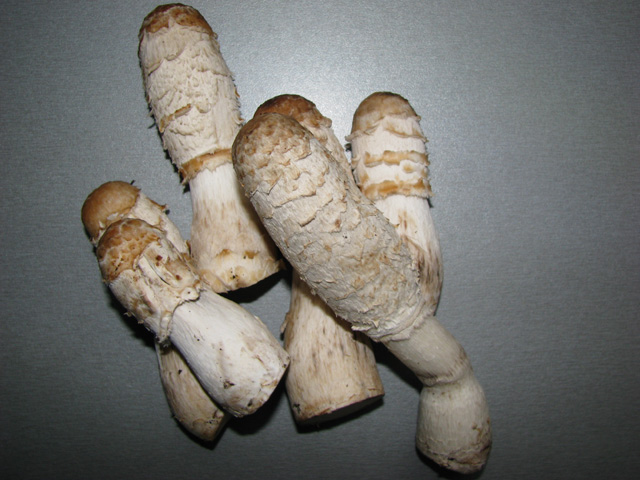
Shaggy ink cap bags after picking and premium quality fruitbodies
The cultivation is quite similar to the technology used for button mushroom cultivation, only the shaggy ink cap needs a certain amount of light. 1-2% spawn is mixed into the compost. The opening of the bags are folded back or covered with paper during spawn run, which takes 2-3 weeks to finish on 25˚C. By the end of spawn run, the color of the compost gets a bit lighter. The compost is then covered with 4-5 cm of good quality casing. During the incubation period the temperature is around 20˚C. The casing soil has to be irrigated at this point, if it has not been watered before casing. To induce fruitbody formation, the temperature is lowered below 20˚C to an optimal 12-15˚C. Higher temperature causes quick development but lower quality.
C. comatus cultivational parameters
|
Compost temperature (°C) |
Humidity (%) |
Duration (days) |
CO2 (ppm) |
|
|
Spawn run |
21-27 |
95-100 |
12-14 |
5-20.000 |
|
Pinning |
16-21 |
95-100 |
12-15 |
500-1.000 |
|
Fruiting |
18-24 |
80-90 |
5-7 |
500-1.000 |
Shaggy mane needs light in fruiting, just like shiitake and oyster mushrooms. Due to quick fruitbody development, the timing of the picking is essential. Only the closed caps are suitable for selling. The mushrooms have to be taken into cold storage immediately. The autolysis of the frutibodies can be slowed down by cooling, but it can even be stopped by scalding (pre-cooking).
Almond mushroom/Almond portobello/Royal Sun Agaricus
Latin: Agaricus subrufescens Peck. (syn. A. bazei Murr., syn. A. brasiliensis Wass.)
Current taxonomic lineage:
- order: Agaricales
- family: Agaricaceae
- genus: Agaricus
A. subrufescens is common in the tropical and subtropical areas of South-America and Asia, but it is also native in California. The species does not occur in the nature in Europe. A. subrufescens prefers nutrient and nitrogen rich areas. The 7-25 cm cap of the mushroom is round and cream-colored at first, but flattens and become chocolate-brown by time. The stem is usually 5-11 cm long, 1,5-3,5 cm in diameter, straight and white. The stem turns yellow if cut with a knife during picking. The immature gills are white and covered by a partial veil. The mature gills and spores are chocolate-brown colored. The fruitbodies grow one by one or in groups. The mushroom has an intense, characteristic almond odor and taste.
Medicinal properties
The species has long been used for relieving the effects of physical and mental stress, for boosting the immune system, for lowering the blood sugar level and preventing osteoporosis. It could be used for treating diabetes and gastric ulcer. It contains a high level of ergosterol, which is the previtamin of vitamin D. Since the extract of the mushroom is proved to be effective on mice cells, against the bacteria Streptococcus pneumoniae, it likely that the same effect can be achieved in human trials. Most trials are aimed at the tumor inhibitory effect of the mushroom extract. The mushroom contains high levels of 1,3 and 1,6 glucans as well. These polysaccharide-type compounds form complexes with proteins. They can be effective against viruses and promote white blood cell formation. The mushroom increases apoptosis (programmed cell death) in the tumor cells. In clinical trial, on cell cultures and in animal experiments the effect of the mushroom on different tumor types has been studied. In case of 12 cancer types (e.g. skin, liver, lung and colon cancer and sarcoma) on cell cultures and animals A. subrufescens was proved to be effective.
Mark Watch presents the medicinal effects of the species and the recently bred hybrid
Cultivation
A. subrufescens is a secondary saprobiont species, which means that it can only feed on materials that are already completely or partially degraded by microorganisms. It can be grown on either compost or sterilized saw dust based substrates. There is a very important difference between the cultivation of button mushrooms and A. subrufescens: the latter needs light for fruitbody formation. During the cropping period A. subrufescens needs compost temperature as high as 25˚C at day and 20˚C at night. One of the most important factors in successful cultivation is the quality of the substrate. The pH has to be set on 7.5 in the compost and 7.5-8 in the casing material. The fermented, chicken manure-based compost used for button mushroom cultivation is suitable for A. subrufescens growing as well. The optimal moisture content is 55-60% at the end of phase II. Casing is done 14-20 days after spawning and it a critical step of the cultivation process. The water holding capacity of the casing soil has to be very well. Due to higher temperatures during cropping, the evaporation is more intense, this species require more water than the button mushroom. More frequent irrigation could cause structure destruction (the top layer could harden), thus the quality of the casing applied 5-6 cm thick has to be outstanding. Experience shows that following the incubation period, no ruffling is necessary, moreover it only causes setback in mycelium growth, which could result in the loss of the first flush. For initiating fruitbody formation, the temperature is lowered, but turned back on during cropping. 85-90% relative humidity is optimal during the formation and growing of the fruitbodies. One flush lasts for a week, and 10-15 days pass between flushes. It is quite common to only have two flushes, since by the end of the second flush the structure of the casing degrades drastically. According to growing experiments, with a high quality casing soil three flushes can be achieved, which means a 10-12 kg yield on 100 kg compost.
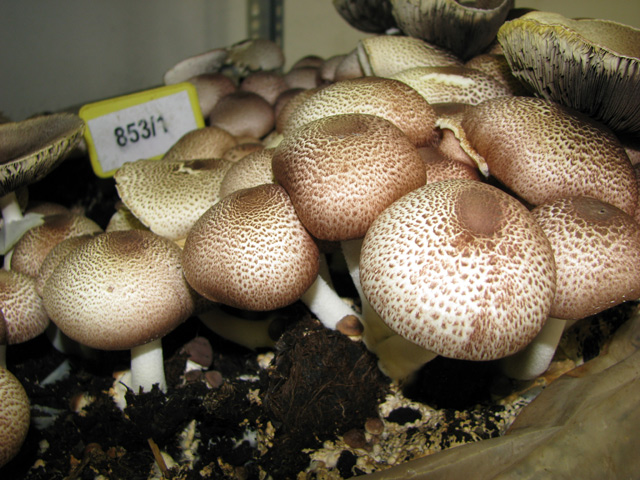
Slightly overmatured A. subrufescens fruitbodies
Recommended ambient conditions of A. subrufescens cultivation
|
Compost temperature (°C) |
Humidity (%) |
Duration (days) |
CO2 (ppm) |
|
|
Spawn run |
25-26 |
90-95 |
12-17 |
5-10.000 |
|
Case run |
24-25 |
90-92 |
8-12 |
2.000-5.000 |
|
Pinning |
21-24 |
85-90 |
8-12 |
<1.000 |
|
Fruiting |
23-25 |
85-90 |
4 -8 |
<1.000 |
Picking is done manually just like in case of button mushrooms (Jump to 6. lesson). The casing soil residues are cut off from the base of the stem and the mushrooms are put into cold storage immediately. The cut ends turn yellow and the discoloration intensifies during storage. That is one of the reasons why the mushroom can only be stored for a few days. This explains why the mushroom is rather marketed in powdered, capsule or dried form. It has been experienced that – due to the higher temperature required by the species – although Hungarian cold cellars are not suitable for the cultivation of A. subrufescens, but the tents and the mushroom houses are.
A. subrufescens is getting more and more popular in Europe: the Dutch company, Prime Champ won an innovation price for their improvements on the cultivation technology of the species on the Fruit Logistica show 2011.
A. subrufescens cultivation in California (button mushroom compost preparation is also shown on the video)
Nameko
Latin: Pholiota nameko (T. Ito) S. Ito & S. Imai
Current taxonomic lineage:
- order: Agaricales
- family: Stropharicaceae
- genus: Pholiota
Nameko originates from Japan and Asia, where it is one of the mushroom species cultivated in the largest scale (besides shiitake – Lentinula edodes and enoki – Flammulina velutipes). It can be found in cool, humid mountainous areas in the nature, where it grows mainly in groups. There are only a few edible species in the genus, since most of them have sticky, slimy surfaces. The stickiness goes away during cooking, while the consistence and the sweet, slightly nut-like taste remains. The cap is light yellowish brown; the gills are white at the beginning but turn brown during maturing. Nowadays the mushroom is available in Hungary as well. The spawn can also be bought, but only a few growers cultivate nameko in Hungary. Since the vegetative mycelium requires high relative humidity, the temperature needs to be quite low for fruitbody formation.
Medicinal properties
There are only few data available on the medicinal properties of the species, but some health beneficial effects have been proven. Frequent consumption lowers the blood lipid level; it boosts the immune system and has anti-inflammatory effects as well. Due to Chinese experiments, the polysaccharides isolated from nameko increase immune response and the functioning of the thyroid gland. Animal tests proved that it is effective in cases of bacterial infections and against sarcoma.
Cultivation
In Asia nameko is cultivated extensively on the trunks of deciduous trees. In intensive cultivation a mixture of sawdust, wood chip and wheat meal serves as substrate. Hungarian experiments showed that dry heat treated wheat straw and corn-cob can be used as well. The sawdust of any species suffice: nameko is one of the rare species that can grow even on pines. Only a 10-20% of supplement is necessary, more nitrogen is not needed. The moisture content of the substrate should be higher (75-80%) than in case of other cultivated mushrooms, since nameko requires more water. The substrate can also be sterilized or pasteurized. Following heat treatment 10-15% of spawn is added to the substrate and mixed thoroughly. The material is then filled into 2-3 kg plastic bags or bottles, which are then placed on shelves or on the ground of the cultivation area. The substrate is colonized in 2-3 weeks, on which point the plastic is removed from the top of the blocks.
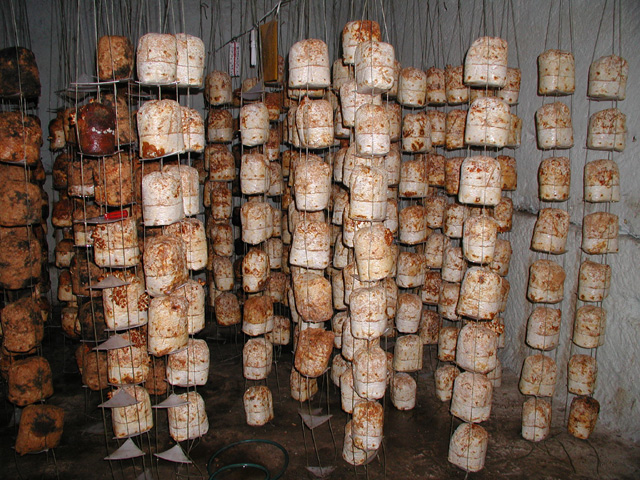
Nameko bags ready for cropping
Since nameko prefers lower temperatures, the substrate has to be cooled down to 10-14˚C. The smaller the bags are, the easier and cheaper is to cool the material down.
The cropping of nameko on a speeded-up video
Recommended ambient conditions of nameko cultivation
|
Substrate temperature (°C) |
Humidity (%) |
Duration (days) |
CO2 (ppm) |
|
|
Spawn run |
24-29 |
95-100 |
12-15 |
>5.000 |
|
Pinning |
10-15 |
98-100 |
7-10 |
500-1.000 |
|
Fruiting |
13-18 |
90-95 |
5-8 |
500-1.000 |
After the primordia appeared, the temperature can be set on a higher level (14-18˚C in the substrate) in order to aid the growth of the fruitbodies. To avoid deformations caused by high CO2 level, fresh air is added continuously. The mushroom requires light during cropping. Fruitbodies with long stems are preferred in the Far East.
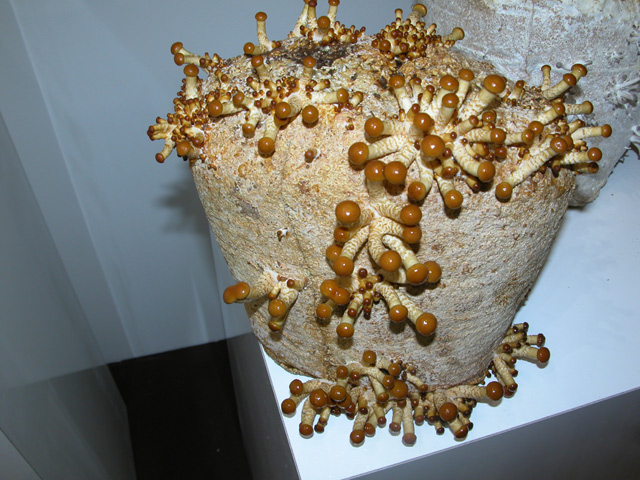
Nameko mushroom ready for picking (for the European market)
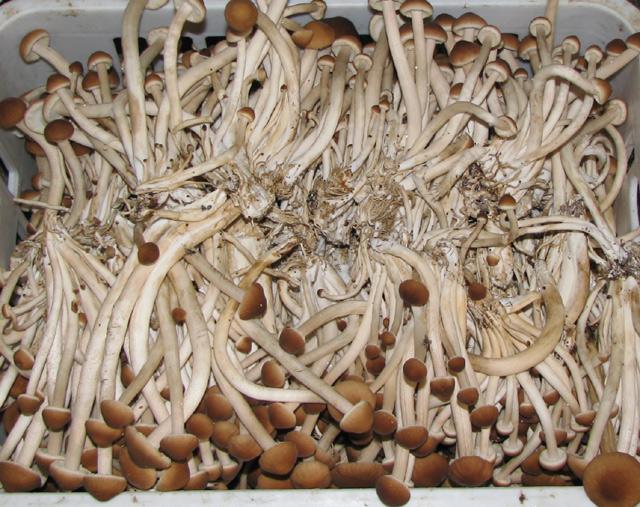
Nameko mushrooms how the Chinese market prefers (with elongated stem)
Since the mushroom requires high water content in the substrate, the blocks are soaked after the first flush. Usually two flushes are picked, which means an average 10-12 kg yield on 100 kg substrate.
Reishi
Latin: Ganoderma lucidum (Curt.: Fr.) Karst
Current taxonomic lineage:
- order: Polyporales
- family: Ganodermataceae
- genus: Ganoderma
Reishi is the most well documented medicinal mushroom. It is known and used in traditional Chinese therapy for thousands of years. The Chinese name of the mushroom is “ling zhi”, which means “the plant of immortality”. In the age of the Chinese emperors, only the most privileged were allowed to consume this mushroom. The mushroom cannot be consumed raw because of the highly bitter taste. Most compounds that cause the unpleasant taste degrade when boiling water is added, but the characteristic bitterness remains. To soften the taste, usually ginger or ginseng is added. The mushroom does not have to be dried in order to be stored. That and the shiny, bright red surface is the reason why it is an ideal material for flower arrangements.
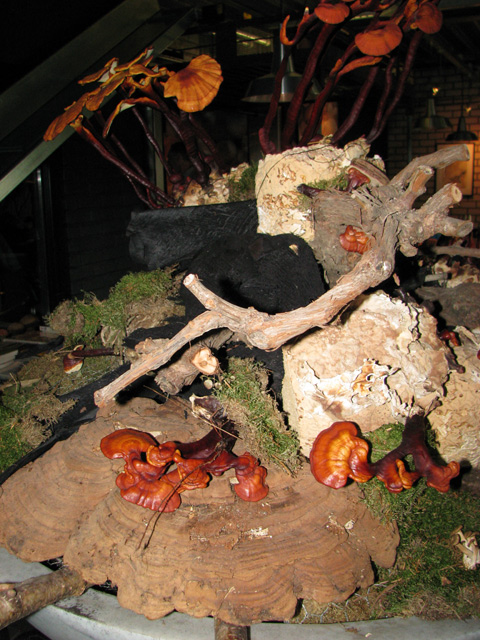
Flower arrangement with reishi and other tinder species
Members of the Ganoderma genus are mostly white rot species. They grow on both deciduous and pine trees. They have strong enzymes, which break down lignin, thus these species can be used for bioremediation purposes and in the paper industry as well. Some species degrade even toxic paints, which is why the textile industry uses them. There are more than 300 members of the genus, which makes the taxonomic lineage hard to follow. There are 6 species native in the Carpathian Basin (e.g. G. adspersum, G. cupreolaccata, G. applanatum etc.) all of which have significant medicinal properties. G. lucidum can be found quite often on oaks in Hungary.
Sándor Gyöngyösi introduces the species in the tv show Gazdakör (in Hungarian)
There are two fruitbody shapes of the species: kidney and antler. The kidney-shaped mushrooms are 5-15 cm, but the size varies. High CO2 level causes longer stems. The color of the cap and the stem is red. On the edge of the cap, a white or yellowish zone can be found. The surface of the cap is very, while that of the stem is moderately shiny.
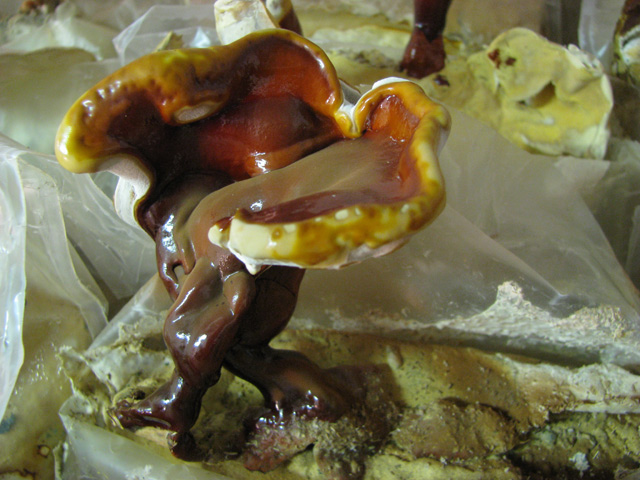
Kidney-shaped fruitbody
Medicinal properties
Similar to the above described medicinal mushrooms, the health beneficial properties of reishi have long been known. That explains why it is a vital part of the Chinese, traditional and preventive therapy. The below mentioned effects are all been proved by animal testing.
The extract of reishi contains mainly polysaccharide molecules, which can inhibit the reproduction of the herpes virus. It is used as part of viral treatments. Another proven effect is that reishi helps preventing pancreatic ulcers. Other compounds lower the blood sugar and cholesterol level, thus increasing oxygen uptake and improving the functioning of the cardiovascular system. The antitumor effect of the mushroom has been described in the 1970s. Similar to A. subrufescens, reishi contains ß-glucans, which has antitumor properties. Long using of products of the mushroom (powder, capsule, and tea) do not cause any side effects. As supplementary treatment in cancer therapy, reishi products could help in easing symptoms of the side effects.
Cultivation
Most cultivation technology descriptions refer to the growing of G. lucidum. (It is hard to tell the difference between the members of the Ganoderma genus, so the technology can be applied in case of other species too). Reishi is a facultative parasite. The fresh fruitbody is not consumed. The health beneficial compounds can be found in the vegetative mycelium as well, and it can be extracted after sterile fermentation. Traditional cultivation can be done by using wood, bottles or bags.
In the Far East extensive cultivation is still quite common. The trunks are inoculated by plug or other spawn. Spawn run and cropping takes place outdoors. The growing cycle is long, but the quality of the mushroom is very good. Some producers first sterilize the trunks and place them into breathing bags in order to minimize the chance of infections and to boost spawn run and to shorten the growing cycle by 50-60 days.
Multi-level reishi cultivation in tents (in Chinese)
For intensive cultivation in bottles or bags a substrate is prepared. The ingredients and the production process are similar to the one described earlier at the cultivation of shiitake and nameko. There are many substrate recipes available. The main ingredients (80-95%) are saw dust and wood chip of different trees. 1-15% supplementation (cornmeal, wheat meal, oatmeal or soy bean meal) is added. If more supplements are added, extra cost have to be taken into account. The risk of infection enhances, although spawn run completes faster.
After the supplements are added, the water content has to be set to 65-70%. The pH is set between 5.5 and 7.2 by mixing calcium carbonate or gypsum into the wet material. The substrate is then filled into smaller (1-3 kg) heat resistant bottles or bags. The bags are sealed by welding or cotton plugs, while the bottles are closed with caps. This step is followed by cooling and spawning under aseptic circumstances (in laminar boxes). In order to achieve uniform spawn run, the spawn should be mixed into the substrate thoroughly. Another but not as common technique is to spawn the pasteurized or sterilized material pervious to filling.
Depending on the rate of the spawn and substrate temperature, spawn run is completed in 10-18 days in clean rooms, on shelves. Since this species need a higher amount of oxygen for fruitbody formation, the bags and bottles have to be opened as soon as the spawn run is finished. At the same time, both the ambient and substrate temperatures have to be lowered. In order to prevent the substrate to dry, the humidity should be kept on a high level. In case of reishi, no casing or irrigation is necessary. The water content of the substrate should be enough for the first flush. The forming of primordia is slower than in case of other species.
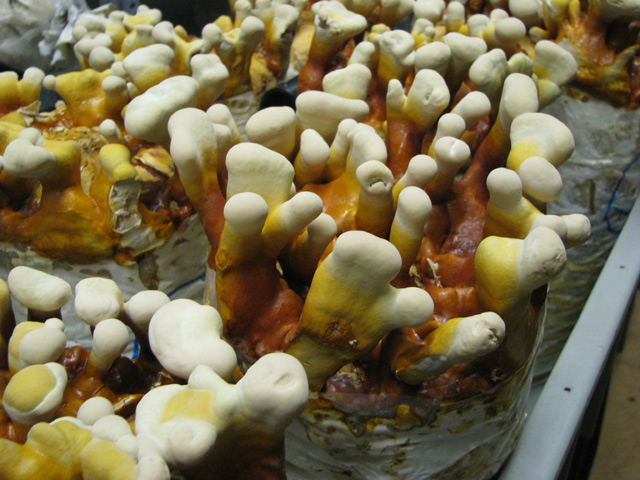
Antler or horn shaped fruitbodies in intensive development stage
According to some authors it is terminated in pinhead stage, whether the fruitbodies are going to be antler/horn or kidney shaped. Higher CO2 level is in favor of antler shaped, while lower CO2 result in kidney shaped mushrooms.
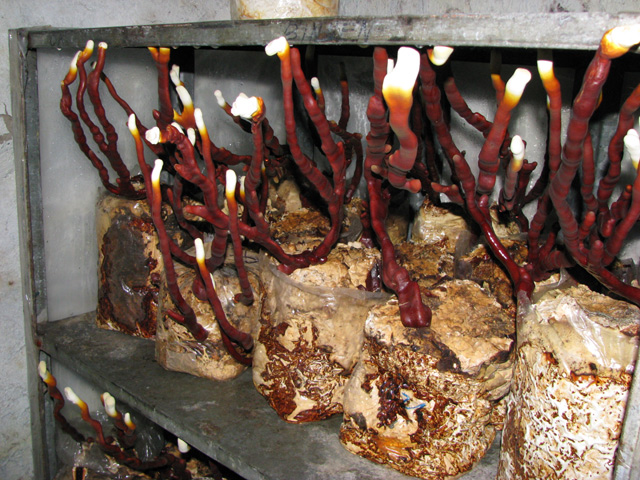
Elongated fruitbodies due to dark and high CO2 level
Besides CO2, genetic background affects the morphology of the fruitbodies as well. In the nature, only kidney shaped mushrooms can be found.
Recommended ambient parameters for growing G. lucidum
|
Substrate temperature (°C) |
Humidity (%) |
Duration (days) |
CO2 (ppm) |
|
|
Spawn run |
30 |
90-95 |
10-18 |
<50.000 |
|
Pinning |
20-25 |
85-95 |
14-28 |
2.000-20.000 |
|
Fruiting |
20-22 |
80-85 |
30-150 |
<2.000 |
Following crop initiation, it could take months for the fruitbodies to develop. Although high humidity is not a basic requirement in this stage, it definitely affects the quality of the product. Since this mushroom needs light, lamps are necessary.
In Far East Ganoderma farms, bottles and bags are laid on top of each other, forming high and tens of meters long walls. This case the fruitbodies appear at the opening of the bags and bottles.
Intensive Ganoderma production in wall-like system
Mushrooms are picked when they are completely developed and stopped growing. The sing of this stage is the darkening of the originally white zone at the margin of the cap. The fruitbodies are carefully but firmly twisted and removed from the surface of the substrate. No additional drying is necessary, since the fruitbodies contain a very low level of water. Although many growers have 2-3 flushes, in Hungary it is rare. Following the first flush, a soaking of the substrate in water helps improving the moisture level, but it also increases the risk of a Trichoderma infection. Irrigating the substrate during cropping might be a safer solution. The yield varies between an average 10-20 kg on 100 kg substrate. It might seem low, but the fact, that reishi fruitbodies contain much less water than button or oyster mushrooms, has also needed to be taken into account.
Monkey head mushroom
Latin: Hericium erinaceus (Bull.) Pers.
Current taxonomic lineage:
- order: Russulales
- family: Hericiaceae
- genus: Hericium
Hericium is a parasite-saprophyte species. It is not very common and is endangered. The fruitbody is white or yellowish and hollowed. The surface is covered by 2-5 cm long spikes hanging down, after which the species got its name. The mature fruitbody is 10-30 cm in diameter. The flesh of the juvenile fruitbody is white, soft and a bit fibrous, but the overmatured mushrooms become yellowish and tough. The odor and taste of the species are not too characteristic.
It is collected in the Far East, but – due to the well developed and relatively easy technology – it is cultivated as well. In Middle Europe it grows from September until November in the nature in the mountainous regions. Hericium is a parasite-saprophyte fungus: it can be found mainly on dead or living, but weakened oak, beech and hornbeam. After the tree is completely damaged, the mushroom continues to live on the decaying material as a saprophyte. As a white-rot mushroom, it can degrade the cellulose, hemicellulose and lignin found in the wood.
Medicinal properties
Traditionally it is used for abdominal and bowel problems. Some descriptions mention anticancer and immunmodulant effects as well. Hericeone and erinacine are the two aromatic molecules responsible for the antibacterial and nematocide properties of the fungus. Fresh fruitbodies can rarely be found on the European markets. Capsules are available and used in China and in Far East.
Cultivation
Some strains of Hericium forms fruitbodies even on petri dishes filled with substrate. These strains are more likely to perform better in vitro, in cultivation. The productivity is lower in case of those strains that develop more aerial hyphae. On the Far East Hericium is cultivated extensively on trunks in larger scale. In Hungary, the extensive technology is not recommended. The substrate has to be pasteurized or sterilized. The sawdust of beech, hornbeam or oak, along with ground wheat straw are ideal substrates, while pine, willow and locust cannot be used. Colonization of pure sawdust substrates is slow, it can even take months, that is why some kind of supplementation is necessary. Grits, cornmeal, or grains can be used for this purpose in 5-15% (dry weight). Another solution is to add more spawn to the substrate, which case the grain (colonized by the mycelium) will act like a supplement. The moisture content of the material than has to be adjusted to 60-70%. The optimal pH is 6.
The substrate is then filled into bags or bottles (each containing 1-3 kg), which are then sealed and sterilized in autoclave. After the substrate cooled, under sterile conditions spawn (grain or sawdust) is added and mixed thoroughly, than the bags or bottles are closed. The optimal temperature for colonization is 25˚C. The process is completed within 3 weeks in a clean, air-conditioned room. Each bottle and bag has filters on them, which allows gas exchange, so the developing mycelium can get fresh air without losing moisture.
Recommended ambient conditions of monkey head mushroom
|
Substrate temperature (°C) |
Humidity (%) |
Duration (days) |
CO2 (ppm) |
|
|
Spawn run |
22-26 |
70-90 |
12-20 |
5.000-40.000 |
|
Pinning |
10-16 |
90-95 |
5-7 |
500-700 |
|
Fruiting |
18-24 |
90-95 |
5-10 |
500-1.000 |
The color of the colonized mixture becomes lighter, but unlike in case of shiitake, where the substrate gets harder, the structure of the Hericium substrate does not change. The next step is to cool the mixture down and to open the caps or seals of the bottles or to perforate the bags. Due to temperature change the fruitbodies start to form within a few days. Hericium fruitbodies need light during development.

Cellar Hericium cultivation in plastic bags in Budafok, Hungary
The primordia are similar to cauliflowers and can be picked within a week. On 20˚C the fruitbodies develop optimally, but on 25˚C they become yellowish and might be dry, which results in a lower quality.
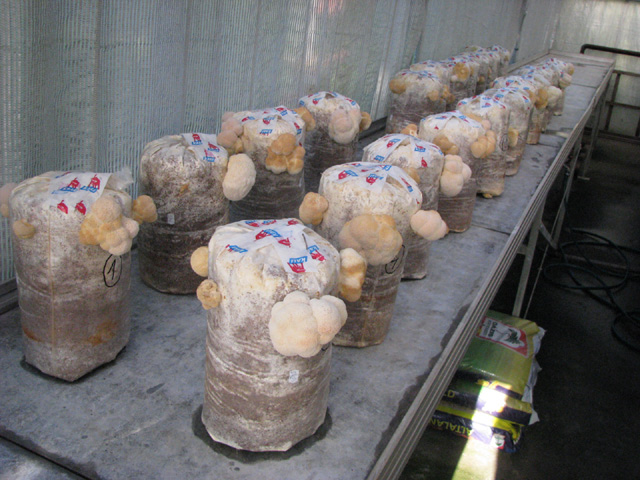
Ready to pick fruitbodies on plastic bags, placed in a glasshouse
The spikes are visible and white on good quality fruitbodies. The mushroom quickly overmatures and turns yellowish. The mushrooms (formed either in the opening of a bottle or on a perforation of a bag) are carefully separated from the substrate, then they are packed and sold fresh or dried. Every residue has to be removed from the bags and bottles in order to prevent secondary infections. Some producers soak the substrate after the first flush, while others just leave it to rest before the second flush. The yield is 20-50% of the weight of the fresh, supplemented substrate.
Check your knowledge!
- Which materials are recommended for shaggy mane cultivation?
- What are the medicinal properties of the almond mushroom?
- What types of fruitbodies does reishi have?
- What are the ingredients of the nameko substrate?
- What are the recommended temperatures in shaggy mane cultivation?
References
Chang, S.T., Miles P.G. (2004): Mushrooms - Cultivation, Nutritional Value, Medicinal Effect, and Environmental Impact. CRC Press, USA.
Chen, A.W. (2004): Growing Ganoderma mushrooms. In: Mushroom Growers Handbook 1. Seoul. 224-234.
Chen, A.W. (1999): Cultivation of the medicinal mushroom Ganoderma lucidum (Curt.:Fr.) P. Karst. (Reishi). IJMM 1: 263-282.
Chen, A.W. (2003): A fresh look at an ancient mushroom, Ganoderma lucidum (Reishi). Mushroom News, 51, 2: 14-24.
Geösel, A. (2011): Agaricus blazei (Murrill) törzsek összehasonlító vizsgálata és termesztésbe vonási kísérletei. Doktori Dolgozat, BCE, Budapest.
Geösel, A., Győrfi, J., Vetter, J. (2009): Az Agaricus subrufescens termesztése és ásványielem-összetétele. Mikológiai közlemények: Clusiana, 48, 1: 25-35.
Gu, Y.H., Leonard, J. (2006): In vitro effects on proliferation, apoptosis and colony inhibition in ER-dependent and ER-independent human breast cancer cells by selected mushroom species. Oncol Rep., 15, 2: 417-23.
Győrfi, J. (szerk)(2012): Gombabiológia, gombatermesztés. Mezőgazda Kiadó, Budapest.
Hobbs, C. (1995): Medicinal Mushrooms. Botancia Press, Santa Cruz, California.
Kerrigan, R.W. (1983): History and biology of Agaricus subrufescens. The Mushroom Journal, 129: 313-319.
Kerrigan, R.W. (2005): Agaricus subrufescens, a cultivated edible and medicinal mushroom, and its synonyms. Mycologia, 97, 1: 12-24.
Lelley, J. (2008): Die Heilkraft der Pilze, Wer Pilze isst lebt langer. B.O.S.S. Druck und Medien GmbH, Goch.
Li, Y., Xiang, H. (2005): Nematicidal activity of Coprinus comatus. Acta Phytopathologica Sinica, 35, 5: 456-458.
Maszlavér, P. (2008): A pecsét viaszgomba, Ganoderma lucidum (Curt.:Fr.) Karst. hazai termeszthetőségének lehetőségei. Doktori Dolgozat, BCE, Budapest.
Mizuno, T. (1995): Kawariharatake, Agaricus blazei Murrill: medicinal and dietary effects. Food Review International, 11: 167-172.
Mizuno, T., Wang, G., Zhamg, J., Kawagishi, H., Nishitoba, T., Li, J. (1995): Reishi, Ganoderma lucidum and Ganoderma tsugae. Bioactive substances and medical effects. Food Reviews International, 11: 151-166.
Moncalvo, J.M., Ryvarden, L. (1997): A Nomenclatural study of the Ganodermataceae Donk. Synopisis Fungorum, 11. p.
Oei, P. (2003): Mushroom cultivation. Backhuy Publishers, Leiden, The Netherlands.
Stamets, P. (2000): Growing Gourmet and Medicinal Mushrooms. Ten Speed Press, Toronto, Kanada.
Stamets, P. (2000): Techniques for the cultivation of the medicinal mushroom Royal Sun Agaricus - Agaricus blazei Murr. ( Agaricomycetideae). International Journal of Medicinal Mushrooms, 2: 151-160.
Szili, I. (2008): Gombatermesztők könyve. Mezőgazda Kiadó, Budapest.
http://www.gombaforum.hu/wp-content/uploads/2010/09/gyapjas_tintagomba_termesztese.pdf

